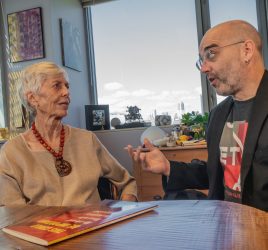As We May Read
I’m going to begin this little essay with the pitch:
I’m working on a two-year research project that will examine how people read, extract what makes the experience pleasurable, and prototype how that experience can be re-created in a digital environment.
There two reasons I’m doing this:
- I’ve returned to graduate school, both to update my current skill set and to learn new frameworks for thinking, and this project will be the eventual final project for my schooling; and
- I believe reading — and storytelling — is at the heart of humanity, and as we move into the digital reading age, I want to explore what that means for us.
If you have some time, please take a few minutes to help me understand how you read today.
My hope is to reach 250 people so that I can create a series of personas related to reading. While I will be publishing this work academically, I will be releasing the results of the survey publicly. (Information wants to be free.)
But I’ll also be sharing this journey with my students (and you) in hopes that they begin to see science, creativity, and school in a different way.
**
In 1945, Dr. Vannevar Bush — the man who founded the National Science Foundation and revolutionized how Americans perceived science — wrote an amazing think piece in The Atlantic called “As We May Think.”
I make many of my students read this essay because I believe it’s important for them to understand ideas such a long-term planning, practical futurist thinking, and aspirational development.
I also want them to understand that Bush — and thousand of other scientists — had a vision for the world we live in today, one permeated by “thinking” devices that enable us to communicate, connect, and network in real-time environments. (J.C.R. Licklider would dub this phenomenon, “Man-Computer Symbiosis” in his equally prescient paper.)
The take-away: the world we live in today was created by people who did serious research that led to creative thinking about how the world may look after they were dead.
That way of thinking is the best of who we are a humans, which is always a positive message to send to people. However, it’s also a powerful reminder that we cannot build that which we cannot conceive.
Creativity is born from science, from observation, from measurement, from analysis. It may not always be formalized, but all creativity springs from that well.
**
As I describe my project to people, I sense a palpable excitement as if we have started to tap into an idea that has existed unspoken.
The goal of the study — and the prototypes — isn’t to define interactivity, or understand game mechanics, or find out how large buttons should be on eReaders. Instead, the goal is to understand what people find pleasurable about paper books and then imagine how that might be replicated — not exactly, but metaphorically — in a digital environment.
We don’t want to recreate the paper reading experience on a tablet; we want to port the pleasures of reading paper books to the digital environment.
We are thinking less about tools, and more about emotions. We are trying to understand the affective tools required by the 21st century author so they can write (or maybe better, create) a modern digital book.
Much of this will be designed by hardware manufacturers in the coming years, something over which we have no control; however, we live in a time where software tools do enable us to explore, experiment, evaluate, and publish into the world while doing the kind of science that will help generations of storytellers that arrive long after my time here has passed.
**
I feel the need to inject this thought at this point: I am not yet schooled in the art of hard science.
The work I am conducting now is part of Interactive Design, which uses soft scientific methods to gather initial data sets in order to extract requirement information for a project and to develop working personas that will aid in prototype development.
This isn’t to suggest that I’m not using scientific methods; I am. As my distinguished colleague Dr. Michael Holmes has pointed out, though, this is not strictly the hard science approach to design. That will come later as I become more steeped in that process. (He’s also prone to pointing out that much of what we see in Humanities these days is called hard science even when it’s clearly not. You can imagine, I enjoy his company quite a bit.)
I share this tidbit of information because I believe we live in a time and place where the word science has lost its meaning. People no longer understand the process of the scientific method, confusing it with opinion and theoretical frameworks that manifest as stories (e.g. Creationism).
Science relies upon hypothesis, objective measurement and testing, evaluation, peer review, and analysis. It is a long, slow process that does not operate in the same time construct of the 24-hour news cycle or the always-on Interent.
Science is a journey to knowledge, not a story to dogma.
**
This little two-year study we are conducting falls well short of Bush’s view of the modern, digitized, networked world. This is just a small cog in the wheel of that machine. It is, in that sense, what science is all about: hyphothesizing, building, testing, measuring, and evaluating in hopes of creating a new bit of knowledge.
Ultimately, I hope my work will be used by publishing companies, universities, writers, and teachers developing digital books, but I have no expectations about that.
We are following his vision, deconstructing the book (which, ironically, he said would likely never go away in his article) in hopes of helping all of us think better, a foundational idea of Licklider’s in “Computer as a Communication Device.”
This is the joy of science, of research, of creativity, of storytelling. We are part of a long vision of what we can be a humans, a vision that is constantly under re-evaluation and re-architecture.
I hope that you will join us along the way.



